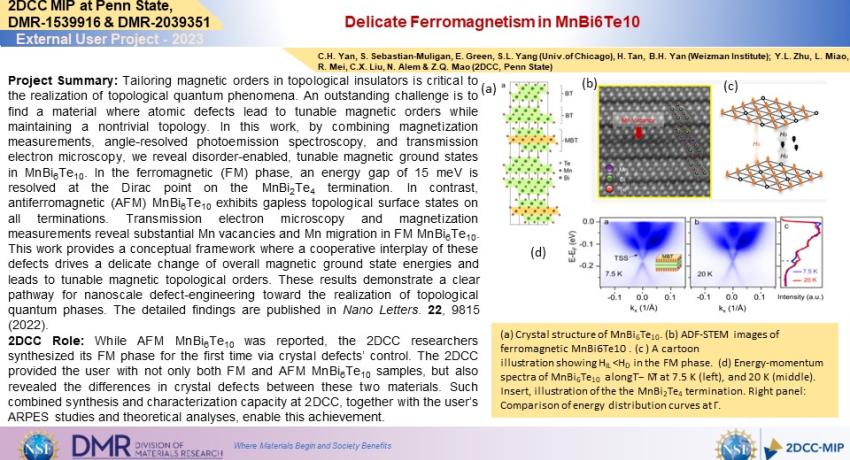Project Summary: Tailoring magnetic orders in topological insulators is critical to the realization of topological quantum phenomena. An outstanding challenge is to find a material where atomic defects lead to tunable magnetic orders while maintaining a nontrivial topology. In this work, by combining magnetization measurements, angle-resolved photoemission spectroscopy, and transmission electron microscopy, we reveal disorder-enabled, tunable magnetic ground states in MnBi6Te10. In the ferromagnetic (FM) phase, an energy gap of 15 meV is resolved at the Dirac point on the MnBi2Te4 termination. In contrast, antiferromagnetic (AFM) MnBi6Te10 exhibits gapless topological surface states on all terminations. Transmission electron microscopy and magnetization measurements reveal substantial Mn vacancies and Mn migration in FM MnBi6Te10. This work provides a conceptual framework where a cooperative interplay of these defects drives a delicate change of overall magnetic ground state energies and leads to tunable magnetic topological orders. These results demonstrate a clear pathway for nanoscale defect-engineering toward the realization of topological quantum phases. The detailed findings are published in Nano Letters. 22, 9815 (2022).
2DCC Role: While AFM MnBi6Te10 was reported, the 2DCC researchers synthesized its FM phase for the first time via crystal defects’ control. The 2DCC provided the user with not only both FM and AFM MnBi6Te10 samples, but also revealed the differences in crystal defects between these two materials. Such combined synthesis and characterization capacity at 2DCC, together with the user’s ARPES studies and theoretical analyses, enable this achievement.
What Has Been Achieved: This work reveals disorder-enabled, tunable magnetic ground states in MnBi6Te10. In the ferromagnetic phase, an energy gap of 15 meV is resolved at the Dirac point on the MnBi2Te4 termination, contrasted with the AFM MnBi6Te10 which does not show gap opening at the surface Dirac point.
Importance of the Achievement: This work demonstrates a clear pathway for nanoscale defect-engineering toward the realization of topological quantum phases.
Unique Feature(s) of the MIP that Enabled this Achievement: The 2DCC researchers not only synthesized both FM and AFM MnBi6Te10 single crystals using the Bi2Te3 flux method, but also investigated the structures of both AFM and FM phases using STEM and found their microstructural differences in Mn vacancies and Mn antisite defects, which provide key information for understanding the magnetic phase tuning by defects in this material. The combined capacity of bulk crystal growth and advanced characterization at 2DCC-MIP enables this achievement. Prior to this work, FM MnBi6Te10 was never reported. The 2DCC’s success in synthesizing its FM phase provides a rare opportunity to understand the magnetic phase tuning via crystal defects’ control. This work shows close collaboration between the 2DCC and users can solve complex problems which can not be solved by any individual group. The major contribution from the user in this work is the demonstration of the surface Dirac gap in the FM phase using ARPES and the theoretical interpretation for the AFM-to-FM phase transition tuned by the crystal defects.
Publication: Chenhui Yan, Yanglin Zhu, Leixin Miao, Sebastian Fernandez-Mulligan, Emanuel Green, Ruobing Mei,
Hengxin Tan, Binghai Yan, Chao-Xing Liu, Nasim Alem, Zhiqiang Mao, and Shuolong Yang, Nano Letters 22, 9815 (2022).
Acknowledgements: The ARPES work was in part supported by the US Department of Energy (DOE), Office of Science, Basic Energy Sciences, Materials Science and Engineering Division, under contract No. DE-AC02-06CH11357, and in part supported by NSF DMR-2145373. The financial support for sample preparation was provided by the National Science Foundation through the Penn State 2D Crystal Consortium-Materials Innovation Platform (2DCC-MIP) under NSF cooperative agreement DMR-1539916 and DMR-2039351. Z.Q.M. acknowledges the support from the US National Science Foundation under grant DM-1917579. C.X.L. and R.B.M. acknowledge the support of the U.S. Department of Energy (Grant DESC0019064). B.Y. acknowledges the financial support by the Willner Family Leadership Institute for the Weizmann Institute of Science, the Benoziyo Endowment Fund for the Advancement of Science, Ruth and Herman Albert Scholars Program for New Scientists, the European Research Council (ERC) under the European Union’s Horizon 2020 research and innovation programme (Grant 815869). N.A. and L.M acknowledge the support by NSF through the Pennsylvania State University Materials Research Science and Engineering Center DMR-2011839 (2020−2026). L.M and N.A. acknowledge the Air Force Office of Scientific Research (AFOSR) program FA9550-18-1-0277 as well as
GAME MURI, 10059059-PENN for support.
